Animal Behaviour - Feathered Einsteins, Mischievious Meerkats and Monkey Vision
This week, will a hot mint still taste cold? Also how skimmed milk could come straight from the cow in future, and why we walk upright without dragging our knuckles. Nicky Clayton discusses clever birds that use cigarettes to fumigate their feathers, Tim Clutton-Brock describes the family affairs of meerkats, and we find out from Andrew Smith why monkeys see what we see, but cats and cows can't. Plus, in Kitchen Science, we get jiggly with a jam jar full of rice.
In this episode

- Does a Hot Mint Still Taste Cold?
Does a Hot Mint Still Taste Cold?
If you eat a chilled chilli pepper, will it: a) Burn your mouth until you beg for mercy from unknown gods? b) Punish you with a brief case of freezer head (ice-cream headache)? c) Feel neither hot nor a cold as the cool temperature might balance out the natural 'heat' of the pepper?
If you aren't brave enough to undertake the research this question might entail, try a more delicious one instead - pop a mint in the microwave for a few seconds, then pop it in your mouth. The mint normally feels 'cool'. Will it still do so if the mint is warm?
 The heat of a pepper and the iciness of a mint are no psychological freak accidents. They are real sensations with similar underlying biochemical causes. Different pieces of information from the 'outside' world create different electrical patterns in our brains. For instance, heat causes the same electrical pattern in our brains each time, so when our brains receive this hallmark pattern, they know to say, 'Oh. Hot. Don't touch.' Cool temperatures create a different pattern, so when we touch something cold, our brains go, 'Oh. Not hot. Cold.' Our brains can get a bit confused though if, say, something like a mint produces the same pattern as cold. We might know that in fact we have just started chomping away on a piece of chewing gum because we put it there ourselves, but our brains tell us, 'Gum. Is. Cold.' (My brain, at least, speaks in halting monosyllables - perhaps my readers' brains are more sophisticated.)
The heat of a pepper and the iciness of a mint are no psychological freak accidents. They are real sensations with similar underlying biochemical causes. Different pieces of information from the 'outside' world create different electrical patterns in our brains. For instance, heat causes the same electrical pattern in our brains each time, so when our brains receive this hallmark pattern, they know to say, 'Oh. Hot. Don't touch.' Cool temperatures create a different pattern, so when we touch something cold, our brains go, 'Oh. Not hot. Cold.' Our brains can get a bit confused though if, say, something like a mint produces the same pattern as cold. We might know that in fact we have just started chomping away on a piece of chewing gum because we put it there ourselves, but our brains tell us, 'Gum. Is. Cold.' (My brain, at least, speaks in halting monosyllables - perhaps my readers' brains are more sophisticated.)
So how do chillis and mints produce the same electrical patterns in our brains that are also brought about by changes in temperature? One way of producing electrical impulses is by allowing ions (electrically charged atoms) to enter a cell by opening a gateway (or 'channel') in the cell membrane, changing the electrical charge within the cell with all sorts of interesting and complicated consequences. Capsaicin - the 'hot' molecule in chilli peppers - alters an 'ion channel' on nerve cells called TRP-V1, that is activated by 'hot' temperatures, causing an electrical change within the cells. Menthol in mints interacts with the same molecule (the TRP-M8 ion channel) on nerve cells that signals cool temperatures. The same pattern will be formed when the channels are opened, regardless of whether temperature change or taste causes it to open, and thus our brains are tricked into perceiving the 'wrong' sensation.
 Back to the original question then: If you simultaneously feed your brain opposing electrical patterns, how can it distinguish between the two? Obviously, this is an extremely complex issue which scientists are desperately trying to unravel with much broader applicability than the somewhat facile question I put forward. In short, how and when do we become confused? And how does accessory information - such as knowing there is a mint in your mouth - direct us in our actions?
Back to the original question then: If you simultaneously feed your brain opposing electrical patterns, how can it distinguish between the two? Obviously, this is an extremely complex issue which scientists are desperately trying to unravel with much broader applicability than the somewhat facile question I put forward. In short, how and when do we become confused? And how does accessory information - such as knowing there is a mint in your mouth - direct us in our actions?
In this particular scenario, it all might depend on whether or not these TRP molecules are found on the same neurones. If the neurones our chilled chilli pepper touches only possess TRP-V1, it will detect the heat but will be unable to respond to the cool temperatures. If the nerve cell expresses both TRP-V1 and TRP-M8 ion channels, then the situation might become confusing for the brain. But as yet, the data about whether the two molecules co-exist on the same cells remains unclear. As a final note, work on these two ion channels, and molecules like them, have further implications for understanding pain and deriving therapeutics. Menthol-containing creams, for instance, can be very good at relieving muscle aches at the same time as acting as an air freshener! Certain types of pain have also been shown to stimulate heat-sensing molecules in the TRP family, which could also explain why your brain can be confused into thinking, 'Vin. Da. Loo. Bad. Pain.' when really it is just a hearty curry well-endowed with hot spices.
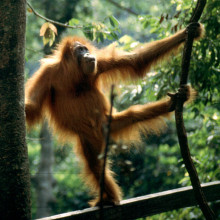
Trees taught us to walk
Have you ever wondered why humans walk on two legs, while pretty much all other animals prefer four? Most human evolution researchers think we started to walk upright through a process beginning with "knuckle walking" on land - the way that chimps and gorillas (and maybe some of the Naked Scientists team!) walk today.
This change was thought to have happened when our ancestors left the forests of East Africa and moved onto the grasslands. But researchers from the University of Liverpool have come up with some evidence to suggest that we actually learned to walk upright by foraging in treetops for food, in a paper published in the journal Science.
Their studies of Sumatran orang-utans have led them to the conclusion that knuckle walking is quite a recent development for chimps, and that the ancient great apes actually spent more time on two legs in trees, holding onto branches for support. So us humans may never have gone through a knuckle dragging stage at all, and skipped straight from tree living to two feet on the ground.
One of the researchers, Professor Robin Crompton explains that "Walking upright on two legs, gripping branches with the feet and balancing themselves by holding or touching higher branches with their hands is actually a very effective way of moving on smaller branches. It helps to explain how early human ancestors learnt to walk upright whilst living in the trees and how they would have used this way of movement when they left the trees for a life on the ground."

Cigs spoil sperm
We've known for a long time that tobacco smoking can cause a range of cancers - in fact, it's believed to be responsible for more than a quarter of all cancer deaths in the UK. And there's plenty of evidence to show that pregnant women who smoke can harm their unborn babies.
But now scientists in Canada have discovered that fathers who smoke could be passing on genetic damage to their kids. The team found that male mice who were exposed to cigarette smoke had changes in the DNA within their sperm. Such changes could increase the risk of cancer, or other diseases in their kids.
The researchers tested mice who had been exposed to similar relative levels of smoke of an average human smoker, and looked at the sequence of a certain stretch of DNA. They found that the rates of DNA mistakes, or mutations, was 1.4 times higher after 6 weeks and 1.7 times higher after 12 weeks, compared to non-smoking animals.
Based on previous studies, the researchers think that their results could be extrapolated to the rest of the genome. Although this work has only been done in mice, it does provide more evidence that men who want to become dads should quit smoking while trying to conceive. Because men constantly generate new sperm, the DNA-damaging effects of smoking are unlikely be so long-lived.

Imitation is the highest form of flattery, and may even save your life
US researchers have found that canny moths impersonate the sounds made by their bad-tasting relatives to ward of bat-attacks.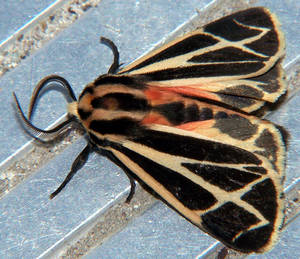
Writing in this week's PNAS, Jessie Barber, from Wake Forest University, trained two species of bats to hunt for moths within sight of two infra-red enabled video cameras. At the same time he recorded the sounds produced by moth prey and the hunting bats. In response to hearing the sonar emitted by bats to locate their meals, some unpalatable tiger moths use a pair of structures called tymbals to broadcast ultrasonic clicks of their own, which are designed to warn the hunter that they taste bad. The bats then duly avoid them. But other tastier moths appear to have muscled in on the trick to avoid being eaten and mimic the bat-repelling sounds with good effect: "we found that bats do not eat the good-tasting moths that make the similar sounds," said Barber. Moths that exercised the right to remain silent, on the other hand, fared less well and were instantly gobbled up.
Why do you get strange patterns when you poke your fingers in your eyes?
This is called an endoptic phenomenon. The eye has amongst the highest metabolic rate for any tissue in the body, higher even than most brain tissue. That's because the retina is incredibly energy hungry, when light shines into the eye, it actually switches retinal activity off, so in the dark your eye is even more active than it is in the light!
When you, for example, stand up from a hot bath, the momentary dip in blood pressure causes you to see funny lights because the blood supplying the retina temporarily drops in flow and reduces the oxygen and sugar available to the retina.
The eye is full of fluid and jelly called aqueous humour, so when you press on it the pressure gets transferred straight to the back of the eye, squashes the blood vessels a bit and changes the pressure. This reduces profusion, it stops blood going in so easily.
Secondly, the physical distortion of the retina itself can cause some photoreceptors to change shape and become less active, firing off impulses when they shouldn't be. This causes internally generated endoptic phenomena.
How loud are whales?
The Blue Whale is the loudest animal in the world and it makes a sound up to about 188dB. For comparison, a jet engine at take off is about 140 dB, and the human pain threshold is about 120dB. Humpback Whales are not as loud, but they're more like the Mariah Carey of the whale world as they have really complex whale songs with a really wide frequency range.
The amplitude of whale song is measured underwater, so although it would be painful to humans, it doesn't hurt other animals in the sea because they have different ears and can tolerate such high amplitudes.

14:08 - Science Update - Planets
Science Update - Planets
with Chelsea Wald & Bob Hirshon
Bob - Hey, Naked Scientists! We were inspired by your last show to talk about planets this week. I'm going to tell you how scientists are using diamonds and lasers to simulate the intense pressures inside large planets. But first, Chelsea has this for us from the Acoustical Society of America meeting that just finished up in Salt Lake City, Utah.
Chelsea - Do you recognize this, Bob? [music]
Bob - Sure. It's the opening riff from Smoke on the Water.
Chelsea - Yeah. And haven't you wondered what it would sound like on Mars?
Bob - Yeah. In fact I wonder that on a daily basis.
Chelsea - Well, you have something in common with physicist Andi Petculescu of the University of Louisiana-Lafayette.
Andi Petculescu (University of Louisiana-Lafayette): It's one of my all-time favorite songs.
Chelsea - He's come up with a new way of simulating sound on different planetary bodies. Here's Venus:
[Smoke on the Water riff on Venus]
Chelsea - It's chock-full of carbon dioxide, which steals energy from the riff's high-frequency tones. Here's Saturn's moon Titan:
[Smoke on the Water riff on Titan]
Chelsea - Titan's atmosphere is a lot like Earth, but it's colder and under more pressure, so the sound travels farther and the music sounds louder. But what about Mars?
Andi Petculescu: Mars would sound like this. [silence] So basically no sound.
Chelsea - Making it not such a great place for the next inter-planetary rock festival.
Bob - Yeah, I guess not. Thanks, Chelsea. Well, pairing gem-quality diamonds with lasers sounds like fashion design, but it's actually a new scientific technique for simulating high-pressure environments. Geophysicist Raymond Jeanloz of the University of California-Berkeley says you first compress a small amount of the material you're studying between two diamonds. Then you send shockwaves through the material using powerful new lasers.
Raymond Jeanloz (University of California-Berkeley): With these very high-powered lasers, it's possible to get to very, very high pressures that previously were effectively accessible only next to nuclear explosions.
Bob - At these high pressures, chemicals behave completely differently; for instance, water becomes metallic. Jeanloz says that outside of labs, these conditions would be found at the cores of supergiant planets beyond our solar system.
Chelsea - Thanks, Bob. Next time, we'll be back to tell you how television watching and moving in with a partner can affect your weight. Until then, I'm Chelsea Wald...
Bob - ...and I'm Bob Hirshon, for AAAS, The Science Society. Back to you, Naked Scientists!
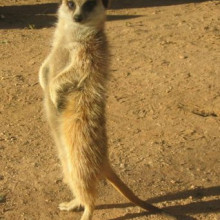
31:16 - Meerkats - Happy Families?
Meerkats - Happy Families?
with Professor Tim Clutton-Brock, Cambridge University
Now to the Kalahari Desert and the study of the most co-operative mammals of all, the Meerkats.But what's the basis of their society and how is it organised? We spoke to Professor Tim Clutton-Brock from Cambridge University about his work with the Kalahari Meerkat Project.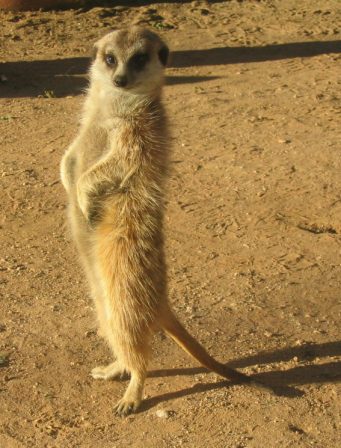 Tim - I've worked on Meerkats now for 13 years and we've managed to tame up, habituate, 14 different groups of Meerkats so we have about 300 animals in the Kalahari which is where we work, and each of those groups, the groups of somewhere between 10 and 40 animals in each group, each has a separate territory of about somewhere between five and ten square kilometres. And we can recognise all those individuals and we have got them so tame that they'll actually climb onto electronic balances at request, so we've trained the Meerkats for crumbs of hardboiled egg to get onto the balances.Chris - What are you ultimately hoping to find out by doing this?Tim - I think the single focus of the study is why they're so co-operative, so the Meerkats are arguably the most co-operative mammal, perhaps it's a near-run thing between them and naked mole rats but Meerkats are very, very co-operative. One female in each group breeds and everyone else in the group helps to rear her pups, males and female group members, fully mature individuals, fully mature males, baby-sit the pups. They help to get food for the pups, they guard the pups, they go on guard in turn so the group is breeding as a unit not unlike an insect society.Chris - How do they decide who is the dominant female?Tim - When you remove a dominant female, all the potential other females compete like fury, they fight commonly, and then one finally emerges and she suppresses the others, she commonly evicts the main challengers over the next few months, and then she turns in and produces children over, oh, it can be five to ten years, so the group gradually becomes a dominant female and the male she's mated to and her children.Chris - So how do they persuade all of their other members of their colony to rear their own, well, the children of the animal that's breeding at the expense of breeding themselves?Tim - Well, that's a very good question. They stop the other females breeding so the presence of the dominant female actually suppresses their fertility so the others can't breed. If they do breed, and they do occasionally, the dominant female commonly kills and sometimes eats their pups.Chris - So that's a pheromonal suppression, is it?Tim - It's probably a pheromonal suppression. It may also be partly through direct interaction because the dominant females are aggressive towards the other females. The other way they help to suppress is that when at particular stages of the breeding cycle, they throw the oldest female subordinates out of the group so one way of getting your daughter to help in Meerkats society is to sling her out into the outside world so she sees just how tough that is and then when she comes back in she's prepared to do the washing up.Chris - I know a few humans who can benefit from that strategy, but quite complicated behaviour. Where do they get it from?Tim - I think the co-operation is associated with desert living and with diurnality, with the fact that they're active during the daytime and if you live in an open desert and you're active during the day, you're very, very susceptible to predators and you've got to come up with some way of combating predators and groups defend each other against predators, they put on guards to keep an eye out, they keep a huge network of burrows as escape systems from predators, so the group is very, very important in keeping predators out.
Tim - I've worked on Meerkats now for 13 years and we've managed to tame up, habituate, 14 different groups of Meerkats so we have about 300 animals in the Kalahari which is where we work, and each of those groups, the groups of somewhere between 10 and 40 animals in each group, each has a separate territory of about somewhere between five and ten square kilometres. And we can recognise all those individuals and we have got them so tame that they'll actually climb onto electronic balances at request, so we've trained the Meerkats for crumbs of hardboiled egg to get onto the balances.Chris - What are you ultimately hoping to find out by doing this?Tim - I think the single focus of the study is why they're so co-operative, so the Meerkats are arguably the most co-operative mammal, perhaps it's a near-run thing between them and naked mole rats but Meerkats are very, very co-operative. One female in each group breeds and everyone else in the group helps to rear her pups, males and female group members, fully mature individuals, fully mature males, baby-sit the pups. They help to get food for the pups, they guard the pups, they go on guard in turn so the group is breeding as a unit not unlike an insect society.Chris - How do they decide who is the dominant female?Tim - When you remove a dominant female, all the potential other females compete like fury, they fight commonly, and then one finally emerges and she suppresses the others, she commonly evicts the main challengers over the next few months, and then she turns in and produces children over, oh, it can be five to ten years, so the group gradually becomes a dominant female and the male she's mated to and her children.Chris - So how do they persuade all of their other members of their colony to rear their own, well, the children of the animal that's breeding at the expense of breeding themselves?Tim - Well, that's a very good question. They stop the other females breeding so the presence of the dominant female actually suppresses their fertility so the others can't breed. If they do breed, and they do occasionally, the dominant female commonly kills and sometimes eats their pups.Chris - So that's a pheromonal suppression, is it?Tim - It's probably a pheromonal suppression. It may also be partly through direct interaction because the dominant females are aggressive towards the other females. The other way they help to suppress is that when at particular stages of the breeding cycle, they throw the oldest female subordinates out of the group so one way of getting your daughter to help in Meerkats society is to sling her out into the outside world so she sees just how tough that is and then when she comes back in she's prepared to do the washing up.Chris - I know a few humans who can benefit from that strategy, but quite complicated behaviour. Where do they get it from?Tim - I think the co-operation is associated with desert living and with diurnality, with the fact that they're active during the daytime and if you live in an open desert and you're active during the day, you're very, very susceptible to predators and you've got to come up with some way of combating predators and groups defend each other against predators, they put on guards to keep an eye out, they keep a huge network of burrows as escape systems from predators, so the group is very, very important in keeping predators out.
Do dogs understand language?
There is a very famous dog, a Border Collie, called Rico who has been written about in the journal "Science" as having a registered vocabulary of 240 words. Rico's owners demonstrated that he has the equivalent learning abilities of a human toddler by showing context-specific learning and attribution. By putting Rico in one room and a number of his toys in another room, and then asking him to retrieve one by name, he would get the right toy. He was then told to go and fetch an item he had never seen or heard of before. This object was placed amongst a collection of toys he knew in the other room. By a process of elimination he was able to pick this object as it was the single item for which he did not know the name. He correctly inferred, therefore, that this must be the item to which his owner was referring. Humans learn by the same deductive process.
So yes, dogs can have a vocabulary and therefore can understand some language and probably use a similar region of their brain to that which we use for language.
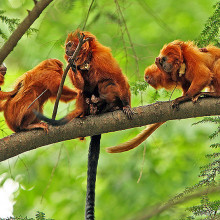
37:26 - A Primates Eyes
A Primates Eyes
with Dr Andrew Smith, Anglia Ruskin University
Dr Andrew Smith works with Tamarin monkeys in South America and the endangered Buton macaque with Operation Wallacea in Indonesia.
Chris - Tell us about this work on how monkeys use colour, and why this is relevant to us.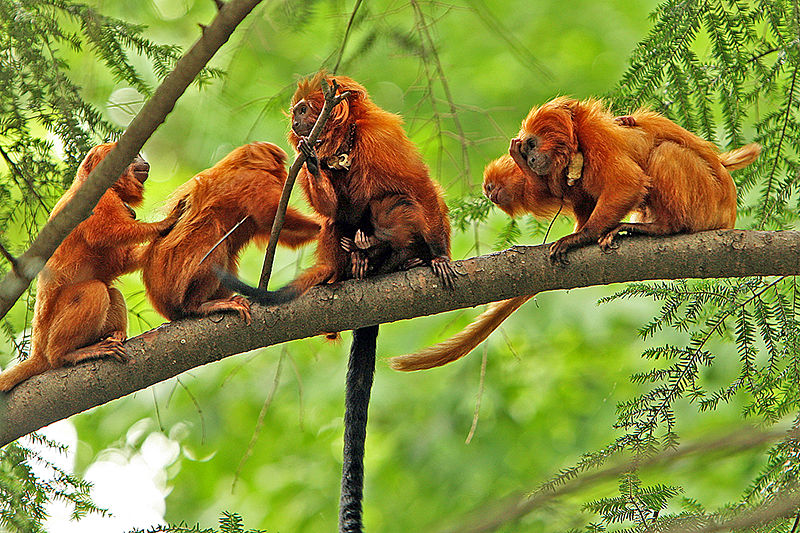
Andrew - Certainly, I've been researching on primate colour vision. It's an interesting topic because primates unlike the majority of animals have got three cone colour vision, which means they can see the same range of colours, more or less, as we can. Non-primate mammals such as dogs and cats see the world in a reduced set of colours, and we weren't entirely sure why this was the case.
Chris - People often say that dogs see the world in black and white, but that's not true. A dog sees the world in colour, but probably akin to how a colour blind human would see.
Andrew - Exactly, if you imagine a dulux colour chart, it's just a reduced set of those colours, not being able to distinguish certain combinations of those, rather than simply seeing the world in black and white or 'an other colour' and white.
Chris - So how was it first discovered that monkeys and other primates did have this ability, it wasn't just us?
Andrew - What they were doing was looking at colour vision capabilities by giving them more or less the same tests that they were giving humans; basically asking them to discriminate between different coloured shapes. If they could tell the difference between the colours then obviously they can tell that those are separate and distinct colours.
Chris - So it's set up so that there's no way they could do that by having two colour- they had to have three colour vision to do that.
Andrew - Yes.
Chris - So what's your view on the reason why they have got that ability?
Andrew - I think the main reason is probably due to foraging ability, so being able to detect fruit against a background of leaves. Leaves are invariably green, but many fruits when they're ripe - which is when plants want animals to eat them and also when they will contain the most amounts of sugars and nutrients, are often orange, yellow or reddish. The ability to distinguish ripe fruits from a background of leaves, which obviously if you are human and colour blind its likely that you have distinct problems telling the difference between red and green, if you cant do this it will be difficult for you to pick out red fruits against a green background. Evolving good three cone or trichromatic colour vision is going to enable primates to choose the ripe fruits against a green background of leaves.
Chris - Is that what we have to thank for the fact that we have such good colour vision?
Andrew - We think so. That's probably the leading theory although there are alternatives that maybe it has evolved to enable you to pick out very young leaves. Young leaves are much more nutritious, they've got less noxious secondary compounds in them than old leaves. For folivorous, leaf eating, monkeys such as howler monkeys or gorillas, and maybe our human ancestors, the ability to pick out the newest, youngest, tenderest leaves may have been a selective advantage for the evolution of three cone colour vision.
Chris - We're not herbivorous, we're omnivorous so we eat some meat but you would have thought that other animals, that actually spend their entire life eating leaves, are dependant on eating plants all the time just to survive. It would be even more important to them, wouldn't it? So why don't cows and sheep and goats have that ability?
Andrew - It's possible that cows and sheep simply haven't had the chance mutation to develop three cone colour vision, and also, being much larger animals they have to graze and consume much larger quantities. Also it really depends on the type of leaf you're talking about. The leaves in terms of primate colour vision are from tropical forests where predation pressure on the leaves is quite high, and interestingly they do flush through a kind of pinkish-red when they're new leaves. However in grasses, the new leaves are basically the same as, or very similar to the adult leaves.
Chris - Is it just fruit that they use this enhanced colour appreciation for or could there be other spin-offs?
Andrew - There could be other spin-offs; it may help to detect predators. If you think about the coats of many cats in rainforests, such as ocelots, margays, jaguars, or indeed leopards, the yellowish hues in their coats may be more easily distinguished if you've got good three cone colour vision.
Kat - Another thing that's important as well as being able to spot predators is to actually find somewhere safe top sleep when you're trying to avoid predators. How do monkeys cope with that when they're living in the wild?
Andrew - It certainly seems for the small monkeys, the tamarins from the Amazon that I've been looking at that, predation is probably one of the most important aspects of their ecology. What they do is try to find the most secure sites, usually high up in trees, often hidden by dense tangles of vegetation and lianas. Also the monkeys really use the sites very infrequently; they change their sleeping site almost every night. The longest I've ever known them to sleep in the same site for is three consecutive nights. This is probably to stop any predators in the area building up a search image and maybe smelling a distinct monkey scent from a particular tree that they've been sleeping in a lot. By changing their sleeping sites very frequently they're hoping to avoid predators.
Will we all evolve to look more similar?
The only reason we look different is due to genetic segregation, people weren't hugely mobile historically and they adapted to suit their environment. People in Africa are usually subject to more sun and ultra violet (UV) radiation and so they developed heavily melanised, brown skin to combat the UV. As people migrated north away from Africa, they were exposed to less UV radiation and it became energetically costly to put all that energy in to making our skin brown when we didn't really need it, so it didn't matter if skin was a little paler.
With the mobile populations we have today, there's a chance that we might see ourselves turning into a more homogeneous mix again.
How can you freeze sperm?
You can freeze all sorts of things, sperm, eggs, embryos. They aren't just frozen in water, they are mixed with a chemical such as dimethyl sulphoxide, which alters the freezing properties of the water in the cells and acts an antifreeze. This stops the water making large crystals and damaging the cells.
- Previous Question and Answer Show
- Next Planets and Cosmology









Comments
Add a comment